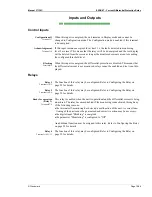
Manual 37138C
ESDR 4T - Current Differential Protection Relay
Page 16/46
© Woodward
Differential Current Monitoring
≡≡≡≡≡≡≡≡≡≡≡≡≡≡≡≡≡≡≡≡≡≡≡≡≡
The monitoring of the differential current is carried out in two stages.
The first monitoring stage serves as a warning and can be enabled or disabled. Should the adjustable warning
characteristic be exceeded, a text appears in the display and a relay contact is enabled. The pick-up time and the
dropout delay of the relay output are adjustable. The warning stage of the monitoring is auto-resetting.
The second stage of monitoring (main stage) serves to initiate tripping. In contrast to the first stage, it offers the
possibility to monitor the overstepping of an adjustable tripping characteristic (I
d
< I
n
) and additionally, a fixed
tripping-threshold of 100%, relative to the generator rated current (I
d
> I
n
). The trigger-delay for each limit value
may be independently adjusted, thus allowing a shorter triggering time at higher differential currents. When one
or both tripping characteristics are exceeded, a text display is initiated and two relay contacts are energized. The
tripping characteristics possess a 2% hysteresis relative to the generator rated current.
The signal relay is only automatically reset if the function "auto-acknowledge relay" in the Entry field on the
screen is configured to "ON". Otherwise, the resetting is carried out by pressing the "Clear" button on the front of
the unit or via the discrete input terminal 18 "Reset".
Tripping Characteristic
The following figure shows the tripping and warning characteristics (with sample values for X12, Y1,and Y2). It
represents the tripping and warning thresholds (Y) relative to the restraint current (X) The coordinates P
(X12/Y2) and P (X12/Y1) the positions of the corner points. The selection of these positions is dependent on the
generator being protected. The following gives the ranges of tripping and warning thresholds:
I
S
/ I
N
0 to X12
The threshold I
d
is independent of the restraint current..
I
S
/ I
N
X12 to 5 × I
N
The threshold I
d
is dependent on the restraint current. A change of 100% in the
restraint current causes an increase of 10% in the tripping threshold.
I
S
/ I
N
> 5 × I
N
The threshold I
d
stays constant at 85%.
Different characteristics can be chosen for the first and second monitoring levels, whereby the horizontal position
(X-coordinate) is valid for both stages. The vertical position (Y-coordinate) can be chosen separately for each
monitoring level. This results in a fixed difference in thresholds of the first and second monitoring levels for each
restraint current I
s
.
The unit can measure currents up to 5 × I
N
accurately. Depending on the vector group there can be a deviation in
measuring the different currents and the unit can trip. The message "range exceeded" is displayed when tripping
due to these currents occurs. Currents larger than 5 × I
N
will only result in tripping if a short circuit is within the
protected area. If the short circuit is outside the protection area, only the generator would be drive the currents
measured by the CTs.
















































